The Moon Maid was written in 1923,
the Moon Men and Red Hawk shortly thereafter by 1926, yet
in its bleak picture of ecological devastation, a society where even the
civilized accepted cannibalism, and the barbarism that overtook all seem
oddly prescient of future dystopias and barren worlds. We can
look at places like the Congo, North Korea, Somalia and Ethiopia and see
the shapes of Burroughs devastated lunar society. He anticipated
the Ukrainian famine, which featured reports of misery and cannibalism,
by ten years. He seemed to anticipate the rise of Hitler and
the repudiation of intellect in favour of brute strength of the Nazis,
the ineffectiveness of their political opposition, as well as their seemingly
unstoppable string of conquests.
Perhaps for this reason, Burroughs dragged his story into
the future. While Barsoom, Venus, Tarzan, Pellucidar and even Caprona
were set loosely in and around his contemporary day, the Moon stories stretch
from the 21st century to the 25th.
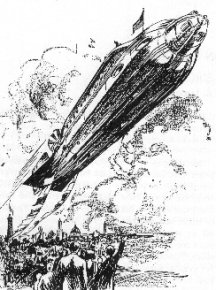 However, the Moon stories are also tightly woven into his other chronicles.
John Carter appears by reference, and the space travel efforts of both
Barsoom and Earth are chronicled. Earth's ship is actually called
the Barsoom. The Martian tales in their turn establish
that communication between the two worlds is effected by the Gridley Wave,
a technology originating in the Pellucidar
series of books, and Pellucidar
itself appears in the Tarzan
series. Meanwhile, another effort to reach Barsoom lands
Carson
on Venus, and
Caprona's
bizarre collection of flora and fauna are aped by Pal
Ul Don in Tarzan, and by Pellucidar as well. So, it's all
part of Burroughs shared universe.
However, the Moon stories are also tightly woven into his other chronicles.
John Carter appears by reference, and the space travel efforts of both
Barsoom and Earth are chronicled. Earth's ship is actually called
the Barsoom. The Martian tales in their turn establish
that communication between the two worlds is effected by the Gridley Wave,
a technology originating in the Pellucidar
series of books, and Pellucidar
itself appears in the Tarzan
series. Meanwhile, another effort to reach Barsoom lands
Carson
on Venus, and
Caprona's
bizarre collection of flora and fauna are aped by Pal
Ul Don in Tarzan, and by Pellucidar as well. So, it's all
part of Burroughs shared universe.
That said, it's a damned contrary and sloppy pseudoscientific
Universe, and the Moon tales match even Caprona for the sheer loopiness
and implausibility of the setting. Burroughs Moon, as described
by Julian, makes no sense at all, even for Burroughs universe.
Thus, as archeologists of unreality, we take the game
up once again, and try to pull the wool over your eyes by making sense
out of nonsense. I'll guarantee you, Burroughs himself never
thought of this stuff, or perhaps he didn't think it all the way through,
or didn't think it carefully. But if we can pound it until
it all fits together, well then... Why not?
Another Hollow World?
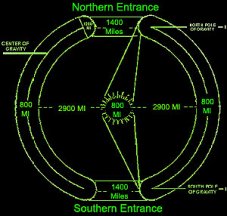 Like Earth/Pellucidar, the Moon turns out to be a hollow world.
According to Julian, the protagonist of the Moon Maid:
Like Earth/Pellucidar, the Moon turns out to be a hollow world.
According to Julian, the protagonist of the Moon Maid:
“I can only account for it,”
I replied, “upon a single and rather preposterous hypothesis, which is
that the moon is a hollow sphere, with a solid crust some two hundred and
fifty miles in thickness...” (Chapter 2)
Given that the existence of Pellucidar must have been
well known to scientists and explorers by the end of the 20th century,
I can't understand Julian's reticence at the theory. However,
it gives us something to work with.
Assuming that the outer moon is similar in size to our
own, approximately two thousand miles in diameter, its surface area is
about sixteen million square miles, or approximately the same space as
Asia. Meanwhile, the two hundred and fifty mile crust on either
side would mean that the inner moon's diameter is about fifteen hundred
miles, with a surface area of only about eight million. Roughly the
size of North America.
For comparison, Earth's total surface area is approximately
two hundred million square miles, including about fifty million square
miles of land.
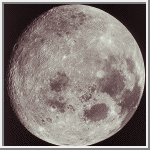 Like our Moon, Burroughs moon appears to be tidal locked, showing only
one face to the Earth. A tidal lock is caused by the drag of the
Earth on the near side of the rotating moon. Over millions, or perhaps
billions of years, this drag steals away energy of rotation, until eventually,
the moon rotated so slowly that its rotation and revolution matched, and
it always had the same face to Earth. Julian refers to two
fifths, the so called ‘dark side’ or ‘far side’ having never before been
seen by man.
Like our Moon, Burroughs moon appears to be tidal locked, showing only
one face to the Earth. A tidal lock is caused by the drag of the
Earth on the near side of the rotating moon. Over millions, or perhaps
billions of years, this drag steals away energy of rotation, until eventually,
the moon rotated so slowly that its rotation and revolution matched, and
it always had the same face to Earth. Julian refers to two
fifths, the so called ‘dark side’ or ‘far side’ having never before been
seen by man.
Unlike our Moon, Julian reports both life and a tenuous
atmosphere on the surface. And of course, it is a hollow world,
as strange as Pellucidar. But if anything, the Moon's peculiarities
are even more dramatic than those of Earth. Consider this:
“There is an atmosphere surrounding
the moon. It is extremely tenuous, but yet it was recorded
by our Barometers at an altitude of about fifteen hundred feet above the
highest peak we crossed. Doubtless in the valleys and deep ravines
where the vegetation thrived it is denser. But that I do not know,
since we never landed upon the surface of the Moon.” (Chapter 2)
“We were descending now....
the barometer recording a steadily increasing atmospheric pressure, though
nothing approximating that necessary to the support of life upon Earth.”
(Chapter 2)
Unlike our Moon, the Moon of Burroughs universe actually
does have an external atmosphere, although this seems tenuous and wispy.
At one point Julian writes that there is no wind upon the surface of the
Moon, which suggests that the atmosphere is too thin to even sustain winds.
Julian is probably wrong about that. But the bottom line is that
apart from deep valleys and ravines, the surface is incapable of sustaining
earthly life.
But then, consider the inside world, Va-Nah, where Julian
discovers:
“It (the barometer) is registering
pressure equivalent to that at the Earth's surface.” (Chapter 2)
And here we begin the first of Julian's many lunar paradoxes.
Why is the interior lunar atmosphere so much thicker than the exterior?
If we look at Earth and Pellucidar, the indications are that both interior
and exterior atmosphere composition and pressure are identical to all intents
and purposes. So why is the moon so different?
Is gravity greater on the inside? There is
no support for this at all:
“In response to my command,
he gave a slight leap to clear the bush and to our amazement as well
as to his own consternation, rose fully eighteen feet into the air, cleared
a space of fully thirty-five feet and lit in the river....
to clear forty feet at a jump was nothing. (Chapter 3)
In short, although Julian never visited the surface, it
still appears that the interior of the Moon's gravity is one sixth of Earth's.
Julian and his companions apparently bound about at ease. At one
point, Julian refers directly to one sixth gravity.
Indeed, in physics the center of gravity would be midway
between inner and outer shells. The gravity on both inside
and outside should be identical. So this does not explain the
heavier gravity.
Perhaps the interior world is sealed in? On
Earth, there are permanent openings at the poles, and perhaps temporary
openings or points of contact elsewhere that would tend to ensure equalized
pressure and atmospheres. A sealed world could have a greater
air pressure inside than outside.
Unfortunately, this is not to be the case:
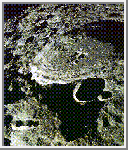 "The secondary source was sunlight which penetrated to the interior of
the Moon through hundreds of thousands of huge craters penetrating the
lunar crust. It was this sunlight which carried heat to the inner
world, maintaining a constant temperature of about eighty degrees Fahrenheit...."
(Chapter Two)
"The secondary source was sunlight which penetrated to the interior of
the Moon through hundreds of thousands of huge craters penetrating the
lunar crust. It was this sunlight which carried heat to the inner
world, maintaining a constant temperature of about eighty degrees Fahrenheit...."
(Chapter Two)
"There are, however, periodic wind
storms which recur with greater or less regularity once each sidereal month,
due, I imagine to the unequal distribution of crater openings through the
crust of the Moon.... The natural circulation of the lunar atmosphere
affected as it is by the constantly changing volume and direction of the
sun's rays," (Chapter Two)
In fact, Julian's ship, the Barsoom enters through one
of these great holes, called Hoos, and the local native civilization acknowledges
the existence of many of these holes. The holes themselves
appear to be wide open, or Julian's ship could not pass. Sunlight
and heat get in, so they are clearly unobstructed. Essentially,
the planet is made of swiss cheese.
Julian goes on to shoot himself in the foot on this issue:
"Centrifugal force, in combination
with the gravity of the Moon's crust, confined the internal lunar atmosphere
to a blanket which we estimated at about fifty miles in thickness over
the inner surface of this buried world." (Chapter Two)
Ahhh. So if Centrifugal force is partly responsible
for the Moon's thick inner atmosphere, then why isn't it forcing that atmosphere
out the Hoos to equalize with the outer atmosphere? And what
centrifugal force anyway? The moon has a 28 day rotation, and
only a quarter of Earth's diameter, it's as slow as molasses!
So, how is it that the Moon's inner atmosphere does not
escape through these holes and equalize with the outer atmosphere?
Julian never gets around to explaining this.
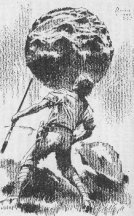 Here's another puzzle. Where does the inner Moon's light and
heat come from. Earth's Pellucidar has its convenient sun,
an object which in another paper, I've speculated is actually a dwarf black
hole. But the Moon....
Here's another puzzle. Where does the inner Moon's light and
heat come from. Earth's Pellucidar has its convenient sun,
an object which in another paper, I've speculated is actually a dwarf black
hole. But the Moon....
"Above us were banks of fleecy clouds,
the under surfaces of which appeared to be lighted from beneath, while
through breaks in the cloud banks we could discern a luminous firmament
beyond, though nowhere was there any suggestion of a central incandescent
orb radiating light and heat as does our sun. The clouds themselves
cast no shadows upon the ground, nor, in fact, were there any well-defined
shadows even directly beneath the hull of the ship or surrounding forest
areas." (Chapter Two)
So, no sun apparent, and no indication of a direct source
of light that would support a sun. Why not? If
Pellucidar has a sun, why not the Moon? And if the Moon doesn't,
why does Pellucidar have one?
Of course, it gets worse:
"This peculiar lunar light interested
us profoundly, but it was some time before we discovered the true explanation
of its origin. It was of two kinds, emanating from widely different
sources, the chief of which was due to the considerable radium content
of the internal lunar soil and principally of the rock forming the loftier
mountain ranges, the radium being so combined as to diffuse a gentle perpetual
light which pervaded the entire interior of the moon." (Chapter Two)
Look, I don't want to be a knit picker, but if there's
enough radium on the inside to light up the entire interior of the world
to ‘hazy earth’ levels... Then there's enough free radiation
floating around that the people are going to glow in the dark, its enough
to sterilize every living thing in there a hundred times over, its enough
to give a Barsoomian a twenty minute life span, its going to be like getting
five hundred X-rays a day.. Sorry, but that's just not going
to work.
“The secondary source was
sunlight....”
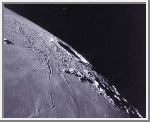 A quote you've already seen. Let me take a moment to point
out that any sunlight is passing through a comparatively narrow (one to
ten mile wide) 250 mile deep hole. This means that the only
time significant light or heat is going to pass through is when the sun
is shining down directly, or at a very steep angle. At best, a Hoos
may only provide light for a day or two.
A quote you've already seen. Let me take a moment to point
out that any sunlight is passing through a comparatively narrow (one to
ten mile wide) 250 mile deep hole. This means that the only
time significant light or heat is going to pass through is when the sun
is shining down directly, or at a very steep angle. At best, a Hoos
may only provide light for a day or two.
There are attendant problems here. If a Hoos
is the source of heat, then there have to be a lot of them in order for
significant quantities of heat to be delivered through the lunar month.
And if a Hoos is at even a slight angle, then its likely
that the sun is warming the air inside the Hoos, but not the inner world
itself. Hot air rises, so actually, the heated expanding air
should be moving upward, escaping into the lower pressure areas of the
surface. Which means that the Hoos should actually be pumping
Va-Nah’s air out onto the surface? Why isn't this happening?
The only conclusion is that even by the fairly relaxed
standards of Burroughs Pellucidar, the Moon's inner world makes no sense
at all. It doesn't work, it can't work, so what's going on?
Towards A Possible Explanation
for Va-Nah's Paradoxes
Taken literally, Va-Nah is unworkable and impossible,
even within the rules Burroughs established for himself. But
there are solutions.
The temptation is to go back to the Moon Maid and
start throwing things out. Hoos are obviously impossible, get rid
of them! Except that Hoos are well established by the objective
experiences of many observers, including the natives, and by Julian's own
entry to the inner world. We can't get rid of Hoos.
Instead, we have to take a disciplined approach to the
facts and theories presented to us by Julian and his companions in the
Moon Maid adventure. This means, occasionally, swallowing facts
that it would be much easier to live without. But it also means
rejecting ideas which are unworkable and replacing them with more coherent
explanations.
At the outset, we must acknowledge that Julian may have
gotten some things wrong. In fact, Julian on several occasions
acknowledges that he is taking wild guesses:
"Doubtless in the valleys
and deep ravines where the vegetation thrived it is denser. But that
I do not know, since we never landed upon the surface of the Moon." (Chapter
2)
So, with respect to the surface of the Moon, Julian cautiously
acknowledges having observed it at a distance, but is generous to reveal
that some of his statements are mere suppositions. Julian actually
guesses a lot. His theory of a hollow world, though correct,
is merely a guess at the time he makes it. He speculates
on the origin of the weather:
"There are, however, periodic
wind storms which recur with greater or less regularity once each sidereal
month, due, I imagine to the unequal distribution of crater openings."
He goes on to make suppositions about the persistence
of the inner atmosphere and its composition:
"Centrifugal force, in combination
with the gravity of the Moon's crust, confined the internal lunar atmosphere
to a blanket which we estimated at about fifty miles in thickness over
the inner surface of this buried world."
Does Julian have a basis for this estimate? I’m
afraid not. The Barsoom took readings of air pressure
from the upper levels of the outer surface, all the way to the surface
of the inner world. There is no indication, during Julian's time
on the Barsoom, that the disabled ship ever ascended to the upper atmosphere
of the inner world. Hence, his estimate is simply a guess,
a theory.
But, I don't want to be harsh on Julian. He
is not a stupid man and his intent is not to confuse or mislead us.
When he discusses the thickness of the inner atmosphere blanket, he goes
on to justify his conclusion:
"This atmosphere rarefies rapidly
as one ascends the higher peaks with the result that these are constantly
covered with perpetual snow and ice, sending great glaciers down mighty
gorges toward the central seas. It is this condition which
has probably prevented the atmosphere, confined as it is within an almost
solid sphere, from becoming superheated,"
In short, we can follow Julian’s logic. On
Earth, as you go higher, the atmosphere becomes thinner and preserves less
heat from the sun. Therefore it gets colder and mountains glaciate.
Julian has taken his experience on Earth and applied it here, trying to
come up with a workable theory as to why the inner surface has not been
cooked by cumulative build up of heat. When Julian is speculating
that there is an unequal distribution of craters, he's trying to explain
another observable phenomena, the winds.
In short, Julian is a not unintelligent man who has a
very limited base of information and theory to work from. Remember,
no one contemplated the moon being hollow, so no one contemplated or speculated
as to what conditions might be like there. Julian's flying by the
seat of his pants. Further, he's working from an extremely restricted
set of observations... He doesn't have the opportunity to spend fifteen
years flying around. At best, he's got some hasty observations
from his ship, while slowly waiting to crash to his death, followed by
a few days of wandering around near the base camp, before he's captured.
His impressions are necessarily subjective, and Julian is generous enough
to let us know that he's frequently guessing. But, I would
argue, he's frequently wrong.
So, what is really going on? I have a few
ideas which may ultimately fit the observed phenomena better than Julian's.
The Hidden Sun of Va Nah
In “Next
Stop, Pellucidar” and “Star
of Pellucidar” (go read them now), I speculated at length about the
dynamics which would create a hollow world.
In fact, hollow worlds are allowed for in our own astrophysics.
A German scientist named Weizsäcker (whose name I have doubtless spelled
incorrectly) worked out the mathematics for stable toroidal cosmic bodies.
A toroid is essentially a donut shape. A hollow world like
Earth/Pellucidar or the Moon/Va-Nah is essentially a distorted toroid.
To simplify things, a rapidly spinning disk of planetary
matter, may if moving rapidly enough, wind up ejecting all of the material
from its core. If it spins too fast, it simply flies apart.
Too slowly, and the material returns to the core. At just the
right speed, however, the evicted material stabilizes in a ring or circle
around the core and your planet stabilizes in a very strange shape.
With respect to Pellucidar, I speculated that one of the
reasons for its genesis was the impact of a small, dwarf black hole into
the center of the protoplanet. It was probably not a big black
hole, its mass microscopically less than that of a star, possibly less
than a planet, and its existence may not technically be allowed for in
our physics (although our physics has predicted even smaller quantum black
holes).
The shock wave of this dwarf impact disrupted the core,
blowing core material out towards the edges, while at the same time accelerating
and stabilizing spin. The core material was driven out to form
a kind of crust or empty ring or globe around which the planet was shaped
surrounding the inner singularity.
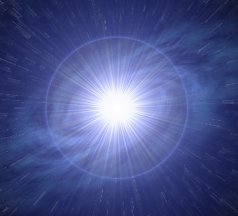 This small singularity, then eventually became the genesis of Pellucidar’s
strange little sun. How? Because, as it absorbed matter
over its event horizon, that absorption was accompanied by the release
of massive amounts of cherenkov radiation. Further, being a
very tiny black hole, it had a likewise tiny event horizon.
Matter has to cross the event horizon to vanish, but the gravity was such
that the press of matter formed an outer shell around the event horizon,
resulting perhaps, in low level fusion. The shell of matter
absorbed most of the radiation, releasing its energy as heat and light.
Thus, we have Pellucidar's sun.
This small singularity, then eventually became the genesis of Pellucidar’s
strange little sun. How? Because, as it absorbed matter
over its event horizon, that absorption was accompanied by the release
of massive amounts of cherenkov radiation. Further, being a
very tiny black hole, it had a likewise tiny event horizon.
Matter has to cross the event horizon to vanish, but the gravity was such
that the press of matter formed an outer shell around the event horizon,
resulting perhaps, in low level fusion. The shell of matter
absorbed most of the radiation, releasing its energy as heat and light.
Thus, we have Pellucidar's sun.
Except that Va-Nah does not have a sun. Or
does it?
Well, okay. Va-Nah does not have an actual sun.
There is no central body radiating heat and light. But what about
gravity, and anomalies of gravity, like the unaccountably thicker atmosphere?
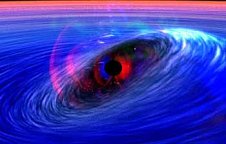 Here's the solution: Like Pellucidar, Vah-Nah has a dwarf
black hole at its centre. This dwarf may be even smaller than
Pellucidar's. Like Pellucidar's dwarf, this black hole has
a tiny event horizon and mass packs tightly around it waiting to be drawn
in. However, eventually, the pressure of gravity around
the shell surrounding the event horizon becomes so great that the shell
effectively crystallizes. Nothing is drawn in.
The black hole, after devouring all stray particles within the shell is
left trapped in a vacuum with nothing to eat.
Here's the solution: Like Pellucidar, Vah-Nah has a dwarf
black hole at its centre. This dwarf may be even smaller than
Pellucidar's. Like Pellucidar's dwarf, this black hole has
a tiny event horizon and mass packs tightly around it waiting to be drawn
in. However, eventually, the pressure of gravity around
the shell surrounding the event horizon becomes so great that the shell
effectively crystallizes. Nothing is drawn in.
The black hole, after devouring all stray particles within the shell is
left trapped in a vacuum with nothing to eat.
Vah-Nah’s ‘proto-sun’ goes dark. Without energy
being released by pressure or particles crossing the event horizon, the
shell is not heated up, does not discharge light or heat. Instead,
it merely sits up there floating in the centre of the moon, largely invisible
and dark.
[I should take this moment as an aside, to comment on
the implausibility of coincidence that the Earth and Moon should both be
hollow worlds. We can accept that by freak of chance, one or
the other might be a hollow world. But the fact that both are suggests
that there is more than meets the eye. Rather, the conditions
that lead to toroid formation of worlds must be relatively common and far
easier in Burroughs universe. In fact, it is possible and even
likely that the natural process for forming Earth or Moon sized worlds
results in toroids, and that other ‘small planet’ worlds in the Solar System,
Mercury, Venus, Mars, Ganymede, Io, Europa, Callisto, Triton, Titan and
Pluto may all be similarly hollow. It may be the ‘solid’ small world
that is the exception to the rule. It may also be quite possible,
even likely, that the ‘dwarf singularities’ that we see in both the Earth
and the Moon, are common, and pivotal in the mysterious formation of the
smaller earth sized worlds of the solar systems.]
But even if the lunar sun produces no light or heat, that's
not the end of the story. Because there is still one force that the
black hole continues to exert, and one force that reaches beyond the level
of the shell: Gravity. It is the accumulated gravity
of the singularity in its shell that wraps it in an immensely thick blanket
of atmosphere. Further away from the singularity and its shell, the
atmosphere thins. By the time its within the area of the inner lunar
surface, it is roughly the thickness of Earth's atmosphere, but diminishing
fast. By the area of the Lunar surface, it is extremely thin.
In short, the Lunar atmosphere inside and outside is not
the property of the Moon, or it would be equal on inner and outer layers.
It is the property of the singularity at the centre. Literally,
we have two systems superimposed one on the other. We have
the singularity and its immense envelope of atmosphere, and we have the
lunar toroid sitting within and at the outer edges of that envelope.
Julian was wrong when he guessed that the atmosphere extended
only fifty miles, and that it would become more rarefied the higher one
climbed mountains. He was merely extrapolating from Earth experience
without actually verifying. In fact, the lunar atmosphere become
thicker the higher you go.
Its composition may well change at higher levels.
The heavier gases and elements are more likely to be held close by the
singularities gravity. The lighter elements like hydrogen and
oxygen are more likely to escape to the outer regions of the envelope.
And in fact, there is support for this in Julian's visual
observations:
"Above us were banks of fleecy
clouds, the under surfaces of which appeared to be lighted from beneath,
while through breaks in the cloud banks we could discern a luminous firmament
beyond."
Notice that although it is only about fifteen hundred
miles, Julian cannot see through to the other side of the moon.
Yes, the Lunar atmosphere is in his way, but through the terrestrial atmosphere
which extends for several thousand miles, we can see the moon, the sun,
stars and planets. Julian sees nothing but clouds, and
beyond the clouds, a luminous haze. This tells us that the
atmosphere is getting thicker, not thinner all the way through.
The clouds, and the continuos cover of clouds (our impression from Julian
is that clouds are a near constant shroud with only occasional breaks)
suggests an interface area, where weather takes place and where the composition
of the atmosphere may well begin to change.
What's another feature of this hidden singularity?
Gravity storms, or perhaps Tidal storms. The lunar atmosphere
is fluid, it is in relatively constant motion. The lunar surface,
both inside and out, however, exerts its own slight gravity.
On the outer surface, this gravity's effect on the atmosphere is negligible,
it's simply added to the existing pull of the singularity.
On the inner surface, however, this slight lunar gravity locally counteracts
the gravity of the singularity. This is why people and rocks
aren't falling off the inner surface towards the hidden core.
The local weak gravity is greater than the diffuse and distant stronger
gravity. You would only start to fall towards the core if you
were able to get a few dozen miles up out of the local gravity.
However, the local gravity pulls at the atmosphere, and pulls in a tug
of war with the singularity gravity at the shifting currents of the atmosphere.
It is at this point in the atmosphere, where the two gravities
compete, at the outer edges of the inner surface's effective gravitational
range, where you will get turbulence. Which is also where,
as a result of turbulence, you will get cloud formation. And
it is in these areas that clouds and currents will occasionally become
volatile, creating super-storms far more powerful and dangerous than those
seen on Earth.
In fact, Julian has seen these super-storms and experienced
them first hand. Not being aware of the singularity, he has
tried to explain them as being the result of sunlight and heat pouring
in from the Hoos in erratic ways. Julian is probably partially
correct in that the beams of heat and light coming in from Hoos do contribute
to or trigger such storms. But these storms are not permanent
constant features as the number of Hoos would indicate. They are
phenomena triggered by the tidal flux.
Of course, being a dark starved boy surrounded by an impermeable
shell, the singularity of Va-Nah produces neither heat nor light.
So it should be cold and dark in this inner world.
Let There Be Light
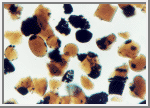 Julian guessed that the source of light, absent any kind of cosmic motor
or residual core heat, could only be from the surface and soil of the planet
itself. In this he was correct. But lacking an
understanding of the planet's gravity mechanics, he could only fall back
on the notion of radioactive decay, and assumed it was radium.
Julian guessed that the source of light, absent any kind of cosmic motor
or residual core heat, could only be from the surface and soil of the planet
itself. In this he was correct. But lacking an
understanding of the planet's gravity mechanics, he could only fall back
on the notion of radioactive decay, and assumed it was radium.
However, there's no evidence that Julian or anyone else
actually verified this conclusion. He never went wandering around
with a geiger counter, for example. So in fact, he got it wrong.
Where's the light coming from?
Piezo-electrics. Here is a fairly little known
fact. If you hit a piece of quartz with a hammer, it will discharge
sparks. If you run an electrical current through a piece of
quartz, it will vibrate. Essentially, for quartz and certain other
crystals, pressure causes it to release electrical energy, while electrical
energy will cause it to vibrate. Piezo-electrics are well established
and you can look it up for itself. Among other things, these odd
physical properties have been used in electronics. Your quartz crystal
watch, for example, keeps time by applying a tiny electrical current to
a tiny piece of quartz and measuring its vibrations.
So, quartz crystals under stress will release light and
electrons. Now normally, this is not a very visible phenomena
on Earth. There have been some suggestions that during Earthquakes,
the discharge of geological energy stresses quartz within the Earth causing
changes in electrical and magnetic fields that animals can detect.
There are even suggestions that quartz stress during or before Earthquakes
may create visible light displays in the sky, as reported by many observers.
But apart from that, Earth is pretty quiet and stable.
The inside of the moon, on the other hand, in some ways,
it not quiet or stable. Specifically, the inside of the moon
is in a mild state of flux between four gravity fields: The
singularity at the centre, the moon shell's own gravity, the sun's gravity
and of course, Earth's gravity.
With respect to Earth's gravity, it is worth noting that
the moon, a body with only 1/64 Earth's volume and 1/80 Earth's mass is
capable of raising tides of eight feet on Earth's oceans against Earth's
own gravity. So imagine the sort of tidal stresses imposed
by a body 80 times more massive, against the Moon's own frail local gravity.
Of course, this doesn't mean that moon rocks will be swept
up and drawn to Earth of their own accord. It doesn't work
that way, the local gravity dominates. It doesn't even mean
that the Moon will experience tides, as Earth does. The Earth
rotates, the Moon always keeps the same face to us.
But tidal effects are subtle. Remember that tidal
effects slowed
the moon's rotation by exerting more gravity on the near
side of the moon than the far side, until the rotation effectively stopped,
leaving the same side facing us? The Earth's tidal effects
on the moon are subtle but constant: Specifically, the Earth's gravity
effect on the surface of the moon facing us is greater than its effect
on the surface facing away from us, and both of these are different on
the inside with the near and far sides as well. Essentially,
the moon's surfaces are experiencing four different degrees of gravitational
and tidal forces at different points (more complicated than that, but I'm
simplifying). Thus, Earth's gravity is always working to deform
the shape of the moon, much like the Moon's gravity deforms the oceans.
Opposed to the Earth's gravity are the Moon's own gravity,
the centrifugal forces of its rotation and revolution, which work to shape
the moon as a hollow sphere, and even the gravity of the singularity at
the centre.
Meanwhile, the singularity adds its own tidal stress because
its tidal gravity upon the inner surface is stronger than its tidal gravity
upon the outer surface of the moon.
And of course, the Sun's gravity, powerful enough to produce
small tides on Earth, produces its own tidal effects as the moon revolves
around the Earth, moving closer and then further from the sun by a half
a million miles.
In short, there are a lot of subtle but profound and powerful
gravitational stresses at work. The impact of such stresses
can be formidable. Io, a satellite of Jupiter, has near constant
volcanic interruptions because of the immense stresses caused by Jupiter's
tides. Burroughs's Moon, like our own, appears to be geologically
dead, but it is clear from Julian's descriptions that there was at least
as much, and possibly much more, volcanic and earthquake activity in the
moon of his universe.
Of course, for the most part, these endless tidal stresses
are not noticeable to the simple observer standing on or inside of the
moon, any more than we notice lunar tides or the movement of geological
plates beneath our feet.
However, the accumulated and constantly shifting stress
would cause quartz or other crystals lining the inner surface to light
up like a christmas tree. Again, the effect is subtle.
Stand next to one, you'd never notice. But cumulatively, over the
whole of the interior, the effect would be dramatic. Thus the
source of Va-Nah’s light.
And the source of something else as well.
Remember when I said that quartz discharged electrons or electricity under
pressure, not just light....
"Why is everyone so terrified?"
I asked her.
"It is Zo-al," she whispered,
fearfully. "He is angry."
It was at that instant that there broke upon my ears the
most terrific detonation I have ever heard. So terrific was it that
I thought my ear drums had burst, and simultaneously, a great ball of fire
seemed to come rolling down from the mountain heights above us.
"The light that devours!"
she cried.
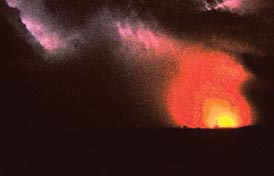 The ground shook to the terrifying noise, and though the ball of fire did
not pass close to us, still I could feel the heat of it even as it went
by at a distance, leaving a trail of blackened and smoking vegetation in
its rear. It must have travelled about ten miles down towards the
sea when suddenly it burst, the explosion being followed by a report infinitely
louder than that which I had first heard.
The ground shook to the terrifying noise, and though the ball of fire did
not pass close to us, still I could feel the heat of it even as it went
by at a distance, leaving a trail of blackened and smoking vegetation in
its rear. It must have travelled about ten miles down towards the
sea when suddenly it burst, the explosion being followed by a report infinitely
louder than that which I had first heard.
I had witnessed my first lunar
electrical storm. (Chapter Five, abridged)
The storm comes upon Julian by surprise. Despite
his theories as to the origins of lunar weather, it catches him unawares,
suggesting that it was not directly connected with turbulence from the
Hoos, which he could have observed and noted. Julian is in
fact quite at a loss for an explanation for this phenomenon, he doesn't
even try. He merely reports it.
We, on the other hand, now knowing that the piezoelectric
crystals are constantly discharging electrical potential into the lower
atmosphere, which is surely the source of the terrible electrical storms
and gigantic ball lightning that so astonished Julian. It also
accounts for the pre-eminence
of electricity and electrical driven communication, transportation and
devices in the history of Vah-Nah’s human civilization, as we see here:
"The more recent history of Va-nah
is one of a singular race of people. All of Va-nah was populated, and they
had ships on all three of its oceans. They also had ships of land (trains)
which were electrically driven and connected all of the cities. In addition,
great carriers flew through the air from city to city. Communication was
by means of electrical energy." (George
McWhorter and Duane Adams, Glossary of the Moon, 1999)
The piezo-electric discharge of light, of course, would
be reflected by the perennial cloud cover, a feature which Julian noted
early. The piezo-electrics would probably also add their own
unearthly luminescence, as static electricity glows around the masts of
ships at sea, a phenomenon known as St. Elmo's fire. Thus,
Vah-Nah is brightly lit, but it is a strange and peculiar lighting, as
noted by Julian in his initial observations.
And of course, we can use the piezo-electric discharge
to answer another fascinating question: The unearthly hues
of the plant life:
"There were forests, too - strange
forests, of strange trees, so unearthly in appearance as to suggest the
weird phantasmagoria of a dream.... The ground about us was covered
with rank vegetation of pale hues - lavenders, violets, pinks and yellows
predominating. Pink grasses which became distinctly flesh coloured
at maturity grew in abundance, and the stalks of most of the flowering
plants were of this same peculiar hue. The flowers themselves were
often of highly complex form, of pale shades, of great size and beauty.
There were low shrubs that bore a berry like fruit and many of the trees
of the forest carried fruit of considerable size and a variety of colours."
(Chapter Three)
On Earth, with only the exception of some purple plankton,
all photosynthesis is carried out by chlorophyll molecules, which absorb
all light except green. On Barsoom, reds and purples predominate.
But here on the Moon, plants appear in a variety of pale hues, including
pinks and yellows, which means that they must be reflecting almost all
the light hitting them. Obviously, they can't possibly be conducting
photosynthesis, not with this assortment of colours and hues.
What's going on? Rather than photosynthesizing
light, they are electrosynthesizing. Their energy is not from light,
but from the inherent static electricity of their environment. The
plants are powering their chemical reactions by devouring or making use
of the electrical potential discharged by the piezo-electrics that pervade
the environment. The flowers may not even be true flowers,
but rather, subtle shapes or organs to maximize their static electric collection.
Simple, non?
Finally,
the Hoos
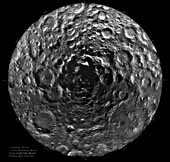 We now turn to the ‘Hoos’ or holes, which much as I hate to admit it, undoubtedly
exist. Julian and his spaceship, the Barsoom, pass through
one such Hoos to the inner world. It is not located at the
pole, as in Earth's entrances, so we must assume it is somewhere beyond
the polar regions. We are told by Julian and we are assured
by the U-Gah that there are many such holes.
We now turn to the ‘Hoos’ or holes, which much as I hate to admit it, undoubtedly
exist. Julian and his spaceship, the Barsoom, pass through
one such Hoos to the inner world. It is not located at the
pole, as in Earth's entrances, so we must assume it is somewhere beyond
the polar regions. We are told by Julian and we are assured
by the U-Gah that there are many such holes.
Julian assumes that such holes, in fact, are caused by
the impacts of asteroids and comets. Personally, I am skeptical.
It strikes me that any asteroid or comet hitting hard enough to bore through
two hundred and fifty miles of planetary crust would probably create a
shockwave large enough to destroy the delicate shell utterly.
The more likely explanation is that Hoos are the geological
leftovers of the Moon's active phase, when it's internal areas where still
heated and flowed like geologically slow liquid. Earth's phase continues.
The Moon has cooled and solidified.
During this active phase, like Earth, the moon's interior
material was in motion, slow motion, but motion, and experienced eddies,
tides and turbulence, probably exacerbated by the various interplay of
tidal gravity. Within such tidal gravities, circular currents
would occur regularly, leading to tiny ‘whirlpools’ or Vortex's opening
between inner and outer worlds. With far less gravity and a
thinner crust, the Vortex's would be much smaller than Earth's and quicker
to form. But the moon was a much smaller world than Earth's and had much
less mass. A vortex, once opened, would tend to cool, and thus
freeze in place. Thus, over time, the Moon accumulated a series
of Voos or Vortice holes before its activities finally stilled.
The presence of so many ‘fossil’ holes between the inner
and outer world's on the Moon suggests that on Earth, these vortex’ or
holes are still actively opening and closing, resulting in hidden features
like Skull Island or Caprona in the Pacific, or in strange geological and
biological mystery areas like Maple White Land in South America or Pal
Ul Don in Africa.
Although Julian had to guess at the origins of the Hoos,
and likely got it wrong, I am happy to say that his observations and theories
of the effect of the Hoos on the Moon's inner atmosphere and weather had
substantially more merit.
It is likely that radiant energy, heat and light from
the sun, are allowed into the inner world through the Hoos on a regular
but intermittent and erratic basis, thus contributing to the interior's
accumulated heat and warmth particularly along the inner surface.
They also probably fuel or create storms, and are partly responsible for
the changes of weather and mild changes of apparent season (although its
unlikely the the interior of the moon actually has seasons in any real
sense, Julian is simply projecting Earth again).
If anything, Julian has probably underestimated the effect
of the Hoos on the local atmospheres of the inner and outer surfaces.
When the sun shines directly through, it is likely that the effect on the
inside is of suddenly standing next to a blast furnace. Light and
heat are discharged incandescently, creating a pillar of fire and a swirling
vortex. It's likely that cloud and atmosphere cover conceals the
true ferocity of the effect. Sidelong sunlight heats the atmosphere
within the Hoos, causing superheated gases to come boiling out both ends.
Eventually, this will result in a heat pump sucking atmosphere from the
interior to the outer surface, this feeds the very thin atmosphere of the
surface. On the surface, the heated gases attenuate spreading
energetically and providing a rare medium to sustain the marginal plant
life. Gravity continually draws the heated gases to lower points
however, and the heated gases sink to low points on the surface like deep
valleys and ravines, and particularly, they sink into ‘dark Hoos’ where
they are drawn back into the interior. Eventually, however, shadows
grow long and the condensing atmosphere is entirely drawn back to the inner
world through Hoos on the dark side or in shadows.
Thus, the outer surface atmosphere, while extremely thin,
is also active. The moon experiences a complex cycle of air movements.
Julian, who never visited the surface of the moon, is once again incorrect,
when he says that the Moon's surface is without wind.
Conclusion
Like so many of Burroughs' heroes, Julian is not a scientist.
Rather, he is an explorer, a gentleman, an intelligent observer of things
and events, and a skillful engineer.
He was also the discoverer and explorer of a wondrous
new world unsuspected by the most brilliant minds of his day.
Trapped on this world by a series of accidents, with only limited observations
and his own native intelligence, it is unsurprising that Julian got things
wrong. You or I would do so in his place, making the same or other
or even greater errors.
That said, we hope that you have enjoyed this little excursion
into Unreal Archeology, in which we discover the dark sun at the centre
of Vah Nah, the reason for its strange anomalies of atmosphere, the source
of its light and even the fundamental energies that powered its biology
and civilization.
~ Den Valdron
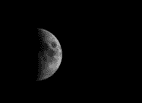
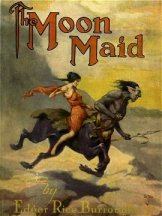

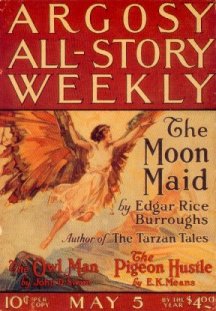
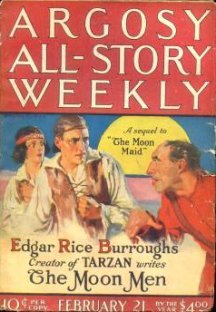

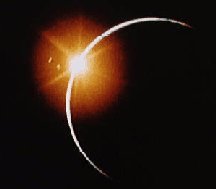
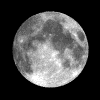
![]()

![]()
![]()

![]()